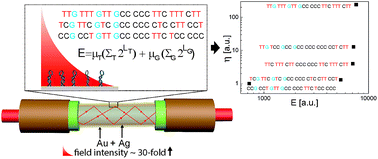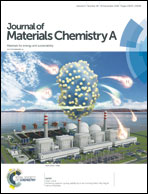DNA sequence-induced modulation of bimetallic surface plasmons in optical fibers for sub-ppq (parts-per-quadrillion) detection of mercury ions in water
Abstract
We demonstrate ultra-sensitive highly-specific detection of mercury ions (Hg2+) in water using a bimetal-plasmonic fiber sensor with single-stranded DNA (ssDNA) containing thymine (T). The plasmonic fiber sensor comprising ssDNA/Au(2 nm)/Ag(50 nm) layers deposited on a fiber core of 3 cm length allows for multiple attenuated-total-reflections (optical leaky modes) to enhance plasmonic effects. The chemo-mechanical folding of ssDNA due to Hg2+ mediated bridging bonds (T–Hg2+–T) enables the device to respond ultra-sensitively to changes in Hg2+ concentration (CHg2+), with a limit-of-detection (LOD) of ∼200 aM. This is equivalent to ∼0.04 ppq (parts-per-quadrillion), the lowest ever reported in Hg2+ optical sensors to date. We also investigate the dependence of Hg2+ detection sensitivity on the sequences of ssDNA. We observe the extremely sensitive dependence of the LOD on the sequence. We build a mathematical model using a type of binary number counting system that describes the largely dominant effects of a sequence on an effective surface index change under plasmonic local fields. We also demonstrate the highly specific detection of Hg2+ among metal composites in water under harsh conditions for such specific detection. This attribute with ultrahigh sensitivity makes the fiber based device well suited for in situ highly sensitive Hg2+ sensors in a portable format.



 Please wait while we load your content...
Please wait while we load your content...